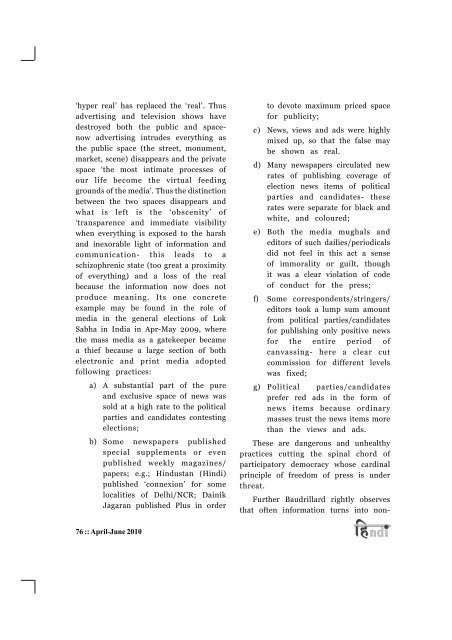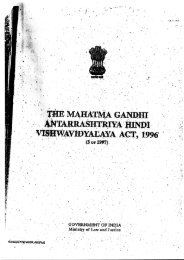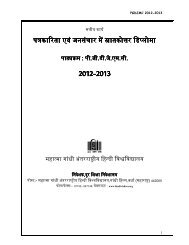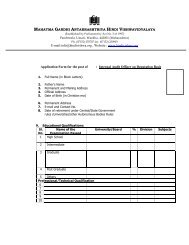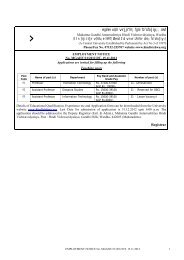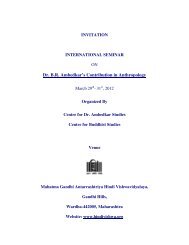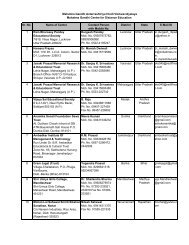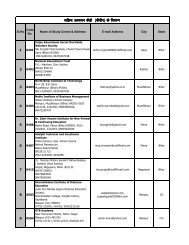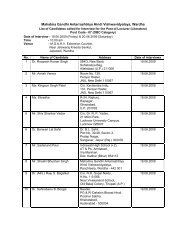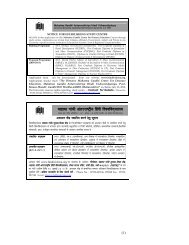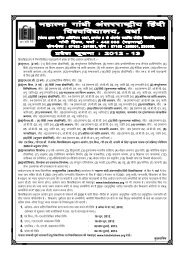Mamta Kalia
Mamta Kalia
Mamta Kalia
Create successful ePaper yourself
Turn your PDF publications into a flip-book with our unique Google optimized e-Paper software.
‘hyper real’ has replaced the ‘real’. Thus<br />
advertising and television shows have<br />
destroyed both the public and spacenow<br />
advertising intrudes everything as<br />
the public space (the street, monument,<br />
market, scene) disappears and the private<br />
space ‘the most intimate processes of<br />
our life become the virtual feeding<br />
grounds of the media’. Thus the distinction<br />
between the two spaces disappears and<br />
what is left is the ‘obscenity’ of<br />
‘transparence and immediate visibility<br />
when everything is exposed to the harsh<br />
and inexorable light of information and<br />
communication- this leads to a<br />
schizophrenic state (too great a proximity<br />
of everything) and a loss of the real<br />
because the information now does not<br />
produce meaning. Its one concrete<br />
example may be found in the role of<br />
media in the general elections of Lok<br />
Sabha in India in Apr-May 2009, where<br />
the mass media as a gatekeeper became<br />
a thief because a large section of both<br />
electronic and print media adopted<br />
following practices:<br />
a) A substantial part of the pure<br />
and exclusive space of news was<br />
sold at a high rate to the political<br />
parties and candidates contesting<br />
elections;<br />
b) Some newspapers published<br />
special supplements or even<br />
published weekly magazines/<br />
papers; e.g.; Hindustan (Hindi)<br />
published ‘connexion’ for some<br />
localities of Delhi/NCR; Dainik<br />
Jagaran published Plus in order<br />
76 :: April-June 2010<br />
to devote maximum priced space<br />
for publicity;<br />
c) News, views and ads were highly<br />
mixed up, so that the false may<br />
be shown as real.<br />
d) Many newspapers circulated new<br />
rates of publishing coverage of<br />
election news items of political<br />
parties and candidates- these<br />
rates were separate for black and<br />
white, and coloured;<br />
e) Both the media mughals and<br />
editors of such dailies/periodicals<br />
did not feel in this act a sense<br />
of immorality or guilt, though<br />
it was a clear violation of code<br />
of conduct for the press;<br />
f) Some correspondents/stringers/<br />
editors took a lump sum amount<br />
from political parties/candidates<br />
for publishing only positive news<br />
for the entire period of<br />
canvassing- here a clear cut<br />
commission for different levels<br />
was fixed;<br />
g) Political parties/candidates<br />
prefer red ads in the form of<br />
news items because ordinary<br />
masses trust the news items more<br />
than the views and ads.<br />
These are dangerous and unhealthy<br />
practices cutting the spinal chord of<br />
participatory democracy whose cardinal<br />
principle of freedom of press is under<br />
threat.<br />
Further Baudrillard rightly observes<br />
that often information turns into non-


